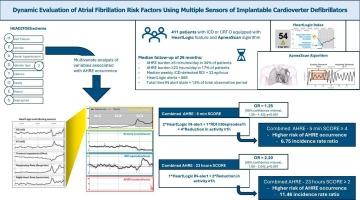应用植入式心律转复除颤器多传感器动态评价心房颤动危险因素
IF 2.5
Q2 CARDIAC & CARDIOVASCULAR SYSTEMS
引用次数: 0
摘要
目的引入HEAD2TOES模式来识别心房颤动(AF)的可改变危险因素(RF),包括心力衰竭(HF)、缺乏运动(PA)和睡眠呼吸暂停(SA)。现代植入式心律转复除颤器(ICDs)可以检测SA,评估HF状态,并测量每日PA。本研究探讨了心衰患者心房高率发作(AHREs)与icd检测到的心房高率发作替代物之间的关系。方法与结果收集411例合并icd的HF患者资料。HeartLogic指数测量HF状态,呼吸障碍指数(RDI)严重SA(≥30次/小时),加速度计检测PA降低(≥1小时/天)。终点为每日AHRE负荷≥5分钟和≥23小时。在26个月的中位随访中,IN-alert-HF状态占总观察时间的13%,RDI≥30次/小时发生的时间为58%,2%的周活动值比平时低≥1小时。139例(34%)患者的AHRE负荷≥5分钟/天,68例(17%)患者的AHRE负荷≥23小时/天。in -alert状态和活动降低均与AHRE负荷(≥5 min/day和≥23 h/day)独立相关,而RDI≥30次/h仅与AHRE≥5 min/day相关。我们定义了预测AHRE负荷≥5 min的评分(2*HeartLogic_IN-alert + 1*RDI≥30集/小时+ 4*Reduction_in_activity≥1 h)和预测AHRE负荷≥23 h的评分(1*HeartLogic_IN-alert + 2*Reduction_in_activity≥1 h)。较低的评分水平(AHRE-5 min <;4和AHRE-23 h <;2)占随访时间的最大比例(98%),得分越高,AHRE的发病率越高(分别为6.75 [95% CI: 1.88-20.16]和11.46 [95% CI: 3.34-31.72])。结论在HF患者中,AHRE的发生与icd检测的HF状态、严重SA和PA降低独立相关。这些icd指标可以作为HEAD2TOES RF的替代指标,有助于持续的房颤风险评估。本文章由计算机程序翻译,如有差异,请以英文原文为准。

Dynamic evaluation of atrial fibrillation risk factors using multiple sensors of implantable cardioverter defibrillators
Aims
The HEAD2TOES schema was introduced to identify modifiable risk factors (RF) for atrial fibrillation (AF), including heart failure (HF), physical inactivity (PA), and sleep apnea (SA). Modern implantable cardioverter-defibrillators (ICDs) can detect SA, assess HF status, and measure daily PA. This study investigates the relationship between atrial high-rate episodes (AHREs) and ICD-detected surrogates for these RF in HF patients.
Methods and results
Data were collected from 411 HF patients with ICDs. The HeartLogic Index measured HF status, Respiratory Disturbance Index (RDI) severe SA (≥30episodes/hour), and accelerometer detected reduced PA (≥1 h/day). Endpoints were daily AHRE burdens ≥ 5 min and ≥ 23 h. Over 26 months of median follow-up, IN-alert-HF state was 13 % of the total observation time, RDI ≥ 30 episodes/h occurred 58 % of time, and 2 % of weekly activity values were ≥ 1 h lower than usual. AHRE burden ≥ 5 min/day occurred in 139 (34 %) patients and ≥ 23 h/day in 68 (17 %). Both IN-alert-state and reduced activity were independently associated with AHRE burden (≥5 min/day and ≥ 23 h/day), while RDI ≥ 30episodes/hour was associated only with AHRE ≥ 5 min/day. We defined a score predicting AHRE burden ≥ 5 min (2*HeartLogic_IN-alert + 1*RDI ≥ 30episodes/hour + 4*Reduction_in_activity ≥ 1 h), and a score predicting AHRE burden ≥ 23 h (1*HeartLogic_IN-alert + 2*Reduction_in_activity ≥ 1 h). Lower score levels (AHRE-5 min < 4 and AHRE-23 h < 2) comprised the largest proportion of follow-up duration (98 %), with higher scores linked to higher incidence rate ratios for AHRE (6.75 [95 %CI:1.88–20.16] and 11.46 [95 %CI:3.34–31.72], respectively).
Conclusions
In HF patients, AHRE occurrence is independently associated with ICD-detected HF status, severe SA, and decreased PA. These ICD-indexes might serve as surrogates for HEAD2TOES RF, aiding in continuous AF risk assessment.
求助全文
通过发布文献求助,成功后即可免费获取论文全文。
去求助
来源期刊

IJC Heart and Vasculature
Medicine-Cardiology and Cardiovascular Medicine
CiteScore
4.90
自引率
10.30%
发文量
216
审稿时长
56 days
期刊介绍:
IJC Heart & Vasculature is an online-only, open-access journal dedicated to publishing original articles and reviews (also Editorials and Letters to the Editor) which report on structural and functional cardiovascular pathology, with an emphasis on imaging and disease pathophysiology. Articles must be authentic, educational, clinically relevant, and original in their content and scientific approach. IJC Heart & Vasculature requires the highest standards of scientific integrity in order to promote reliable, reproducible and verifiable research findings. All authors are advised to consult the Principles of Ethical Publishing in the International Journal of Cardiology before submitting a manuscript. Submission of a manuscript to this journal gives the publisher the right to publish that paper if it is accepted. Manuscripts may be edited to improve clarity and expression.
 求助内容:
求助内容: 应助结果提醒方式:
应助结果提醒方式:


